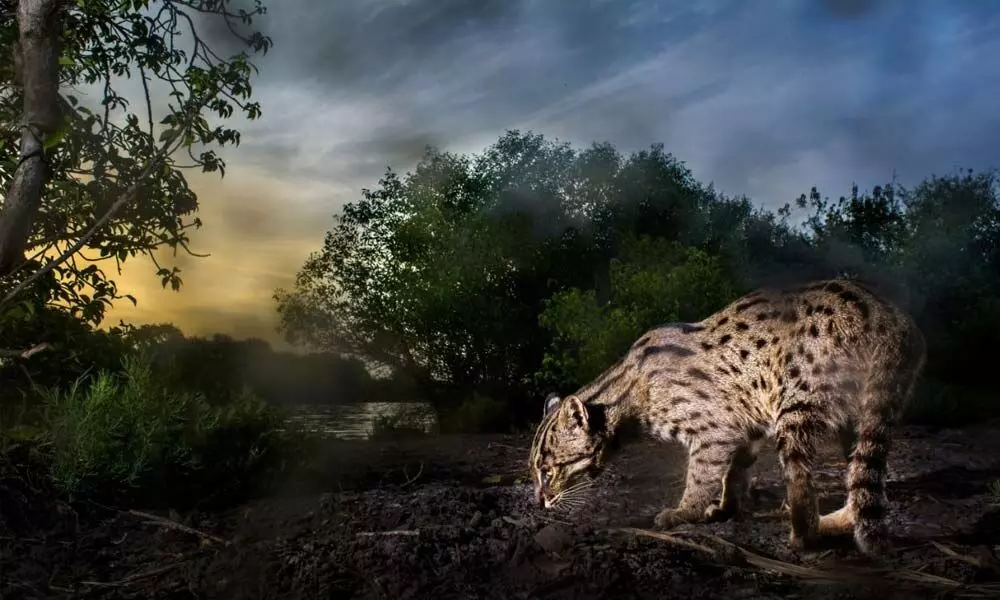Live
- Karnataka Temple Embraces Mechanical Elephant for Cruelty-Free Ceremonies
- Temple modelled after Ram Mandir to be constructed in US
- Property dealer shot dead in broad daylight in Ranchi
- Maharashtra: CM Fadnavis expands Cabinet; inducts 39 ministers
- Winter Session of UP Assembly from Dec 16; CM seeks cooperation of all parties
- AIADMK executive council meet passes sixteen resolutions, vows to make Edappadi CM again
- Manchu Family Feud Resurfaces in Jalpally
- Kerala Hindu leader gifts Rig Veda to Pope Francis
- 35 miners trapped under rubble in Afghanistan
- Lavanya Tripathi's Birthday Gift: Title Announcement of Her New Film ‘Sathi Leelavathi’
Just In
Kakinada: Fishing cats in Coringa Sanctuary to be collared


The Forest Department officials conducted a census in 2018 had recorded the existence of more than 110 fishing cats in the Coringa Wildlife Sanctuary
This is the first of its kind porject in the country
Kakinada: For the first time in the country, a fishing cat collaring project will be initiated in Coringa Wildlife Sanctuary (CWS) in East Godavari from next week.
The project has been taken up by the conservation biologists of the Wildlife Institute of India (WII) at Dehradun. The Union Ministry of Environment, Forest and Climate Change accorded permission for starting the project at CWS abetting Kakinada. The country's first such project will be led by principal investigator Dr Bilal Habib. Already, the State Forest Department has released Rs 45 lakh of the total project cost of Rs 75 lakh which is entirely funded by the Vedanta groups through its CSR funds.
Dr Bilal Habib told "The Hans India" that they are trying to find out the special species of fishing cats available in the CWS. He said that they are going to start a fishing cat project very shortly in CWS of East Godavari. The Ministry has directed and permitted for starting a fishing cat project in Coringa forest. He added that their team of experts will arrive and study the ways and means of exploring the habitat, food habits and other living conditions of fishing cats in the forest.
He said that while conducting the project camera traps will be deployed in the sanctuary and adjoining areas. He said that with the help of cameras they will study the movement habitation and food habits and mode of reproduction and allied activities of the fishing cat in the CWS. He said that the research work would commence in the month of December. "They would continue to stay till January 2022."
Divisional Forest Officer (DFO) of Wildlife C Selvam said that the census project identified 115 fishing cats in the CWS. "The study would concentrate on this particular species of fishing cat," he said and added that they would study the existing number of fishing cats, their eating habits and their mode of reproduction and rearing their species.
Even though they plan to conduct research in 2020, they couldn't do so owing to the pandemic. He said that they can continue the project for nearly three years. The project will capture 10 fishing cats for collaring to study its habitat, feeding habits.
The sanctuary is also an important habitat for the birds and more than 234 species of bird including black-headed gull, common sandpiper, red shank, little egret, cattle egret, grey heron, western reef heron, open billed stork, pied kingfisher, black capped kingfisher and small blue kingfisher and other are found in the Sanctuary. Recently, the Ministry of Environment, Forest and Climate Change has declared 177.30 sqkm surrounding the sanctuary as an eco sensitive zone.

© 2024 Hyderabad Media House Limited/The Hans India. All rights reserved. Powered by hocalwire.com






